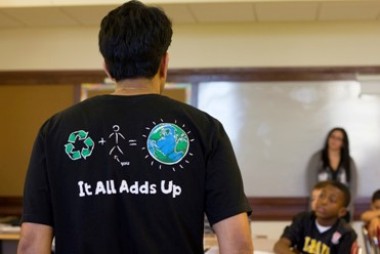Telling our Story of Public Engagement
UAlbany Develops Milestone System to Track Commitment
 |
|
A new campus data collection system will systematically document public engagement outreach in scholarship, teaching, learning, and service.
|
A new campus data collection system for public engagement, developed by the President’s Public Engagement Council, the Office of Institutional Research, Planning and Effectiveness (IRPE), and other units, will seek to address that need.
The University has a compelling story to tell its constituents, from the general public and key stakeholders to policy makers and funders. This new system will better position the University to garner their support, advance partnerships, integrate efforts for greater impact, and celebrate those involved.
The data collection system, announced by President Robert Jones and Provost James Stellar at the campus-wide March forum Telling Our Story of Public Engagement, will also be key to answering the following:
• How many UAlbany faculty, professional staff and graduate students are conducting publicly engaged research, teaching and service?
• Who are their partners, what fields are involved and what are the areas of outcome and impact?
• Who are the intended beneficiaries and where are they located?
• What are key examples of how UAlbany improves the quality of life and addresses critical societal needs?
"This new system is a milestone for the University," said President Jones. "Public engagement is a core value of a public research university and part of UAlbany’s DNA. I am extremely pleased with the work UAlbany has done to advance this work."
Provost Stellar emphasized his support, saying that “on the academic side of the University, I am completely behind this work.” He specifically noted how faculty engagement efforts will help attract and retain students.
The system, which relies on self-reporting, involves a common language, and the President highlighted two commonly misunderstood terms, which he defined as:
• Public engagement
“Collaborations between institutions of higher education and their larger communities … for the mutually beneficial exchange of knowledge and resources in the context of partnership and reciprocity.” (Carnegie Foundation for the Advancement of Teaching).
• Communities or Publics
Individuals, groups or entities external to UAlbany that share something in common – such as an interest, occupation or identity. They can be local or global and involve fields ranging from the arts and humanities to the hard sciences and social sciences.
“My vision is to put great emphasis on partnerships, reciprocity and the exchange of knowledge because they are what it takes to solve critical societal challenges,” said President Jones. He noted that activities can run a broad spectrum from those activities for communities where the University offers a resource or service, to true partnerships with communities. The Albany Promise Cradle-to-Career Partnership is an excellent example of the latter.
The new system will record annual activities from May 1 – April 30, with timing as noted below:
• Faculty can start anytime to record these activities in the Faculty Activity Report, which has some new features. This year the general University-wide deadline is June 30, but a few schools or colleges may have an earlier deadline. Faculty should check with the dean’s office.
• Non-tenure track faculty, professional staff and graduate students can participate through the appropriate voluntary survey which they will receive in early April. The due date is May 31.
• Undergraduates can record their experiences through MyInvolvement. They will get a record of all their experiences from their first day at UAlbany to graduation.
Data collection starts in early April, and UAlbany students, faculty, part-time instructors and professionals are encouraged to participate. To request more on the system and public engagement, contact [email protected].
![]() For more news, subscribe to UAlbany's RSS headline feeds
For more news, subscribe to UAlbany's RSS headline feeds
A comprehensive public research university, the University at Albany-SUNY offers more than 120 undergraduate majors and minors and 125 master's, doctoral and graduate certificate programs. UAlbany is a leader among all New York State colleges and universities in such diverse fields as atmospheric and environmental sciences, business, education, public health,health sciences, criminal justice, emergency preparedness, engineering and applied sciences, informatics, public administration, social welfare and sociology, taught by an extensive roster of faculty experts. It also offers expanded academic and research opportunities for students through an affiliation with Albany Law School. With a curriculum enhanced by 600 study-abroad opportunities, UAlbany launches great careers.


